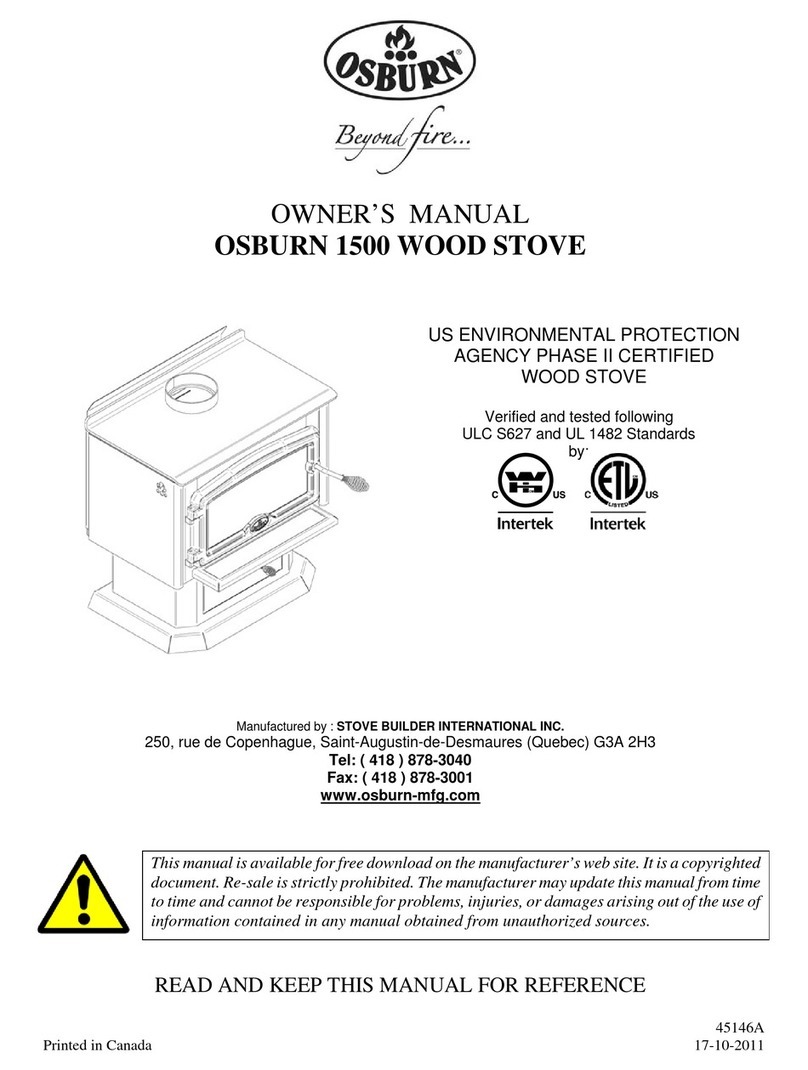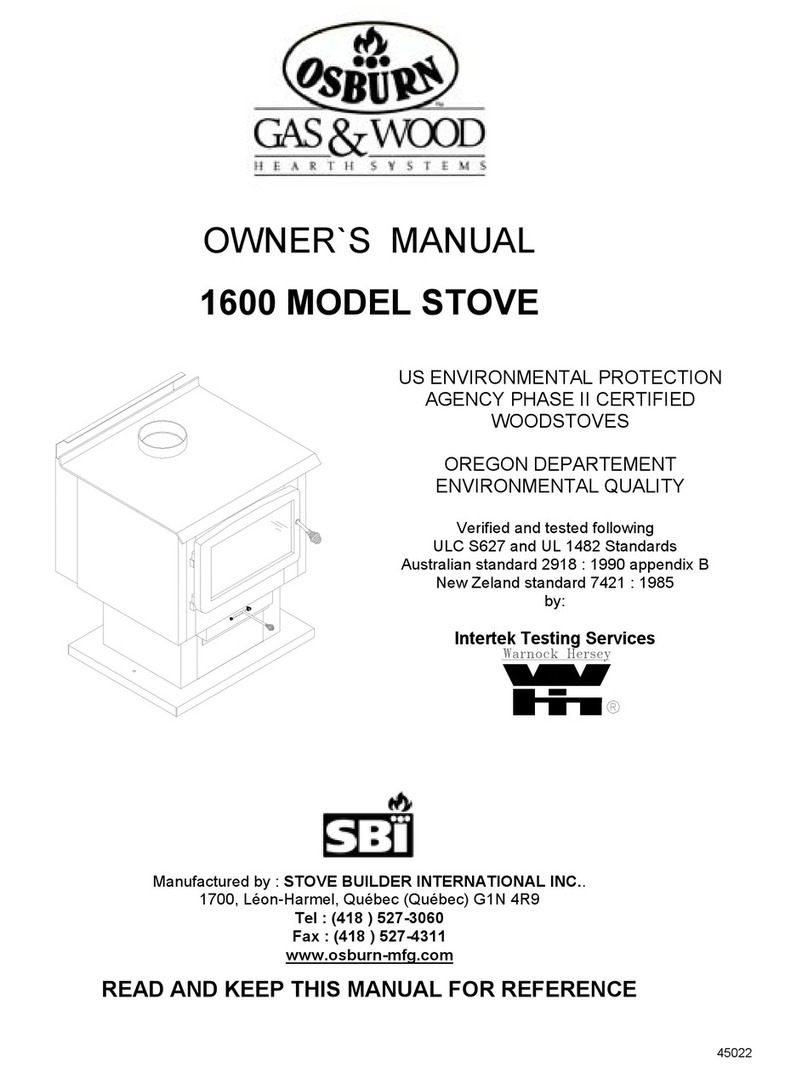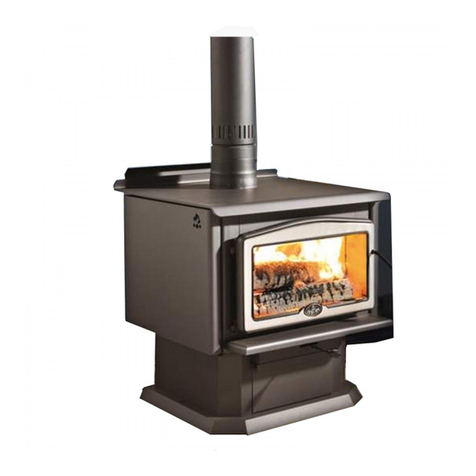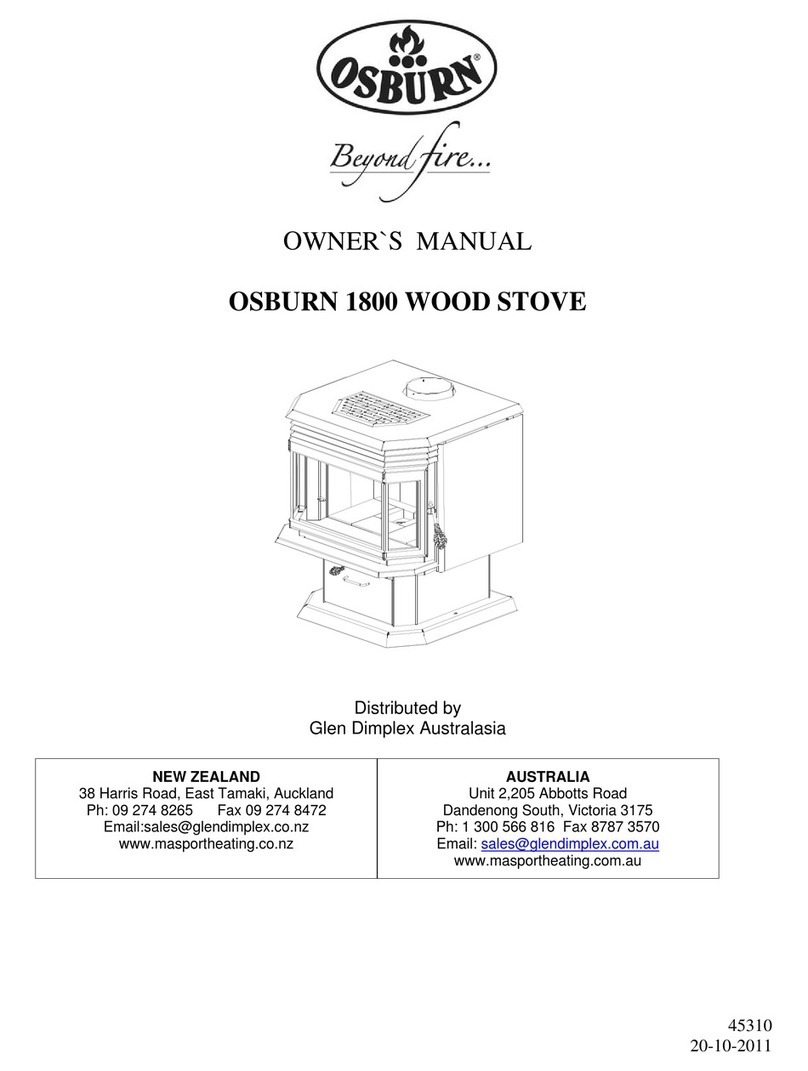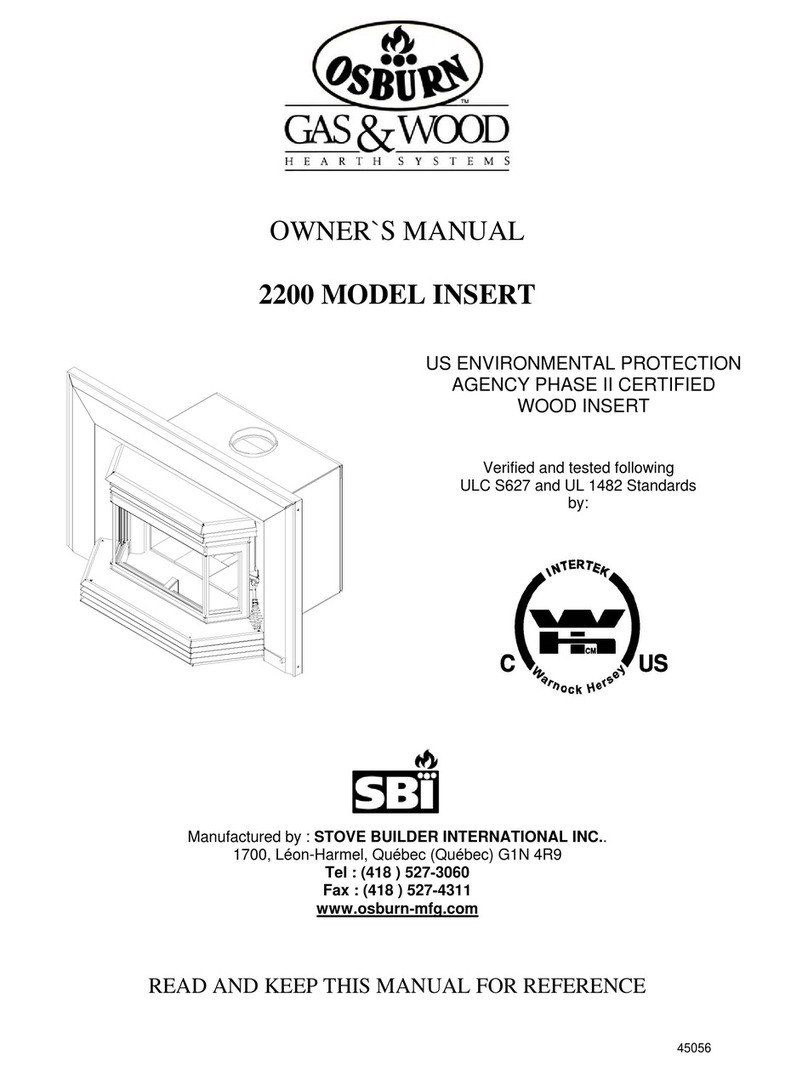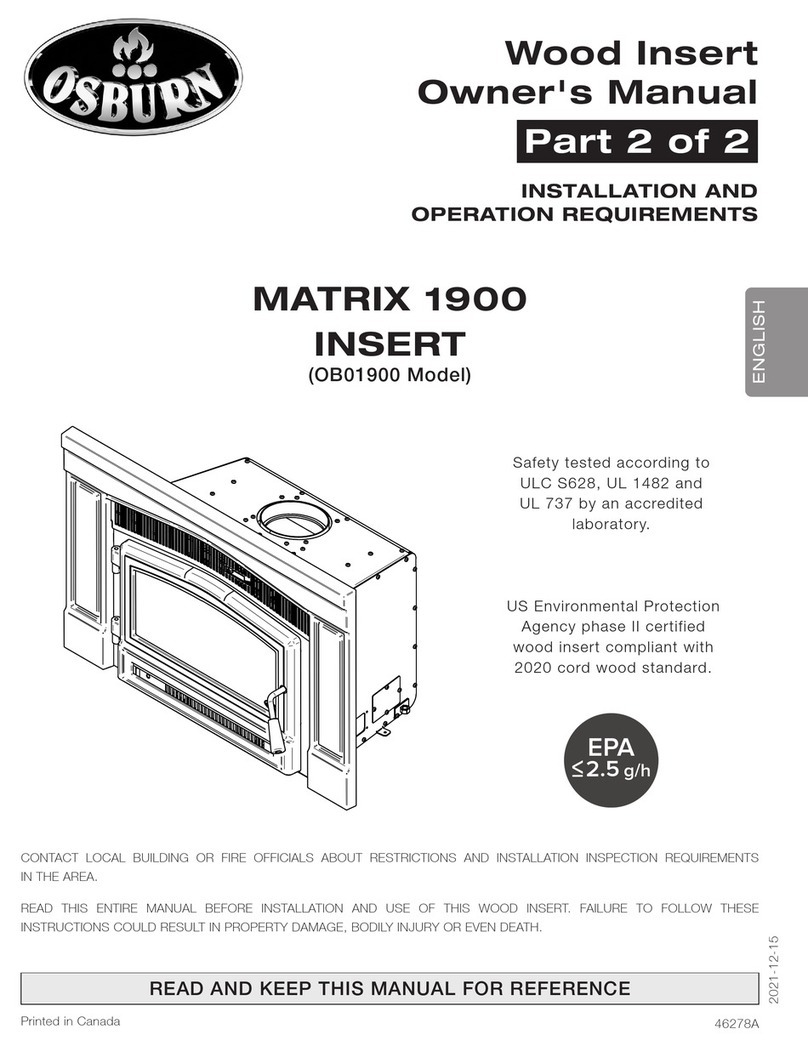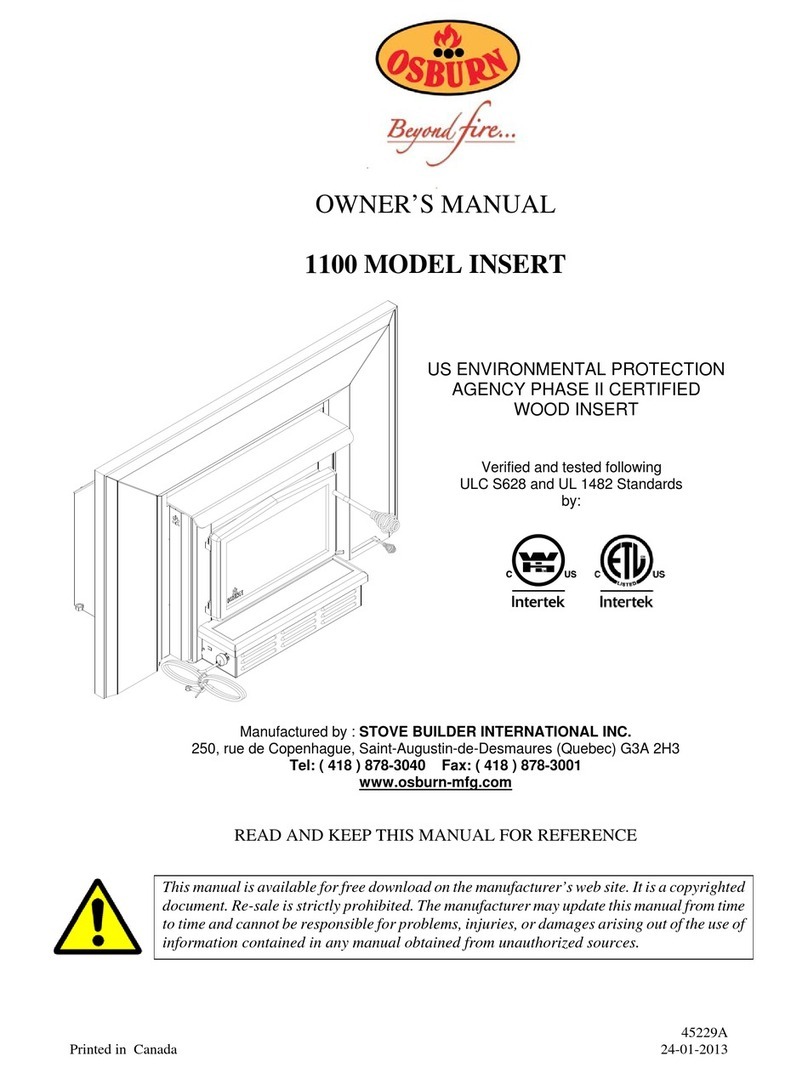Osburn OB00915 User manual

READ AND KEEP THIS MANUAL FOR REFERENCE
45972A
Printed in Canada 2019-01-21
INSTALLATION AND OPERATION MANUAL
OSBURN 900
(OB00915 Model)
Distributed by
Glen Dimplex Australasia
NEW ZEALAND
38 Harris Road, East Tamaki, Auckland
Ph: 09 274 8265 Fax 09 274 8472
Email: sales@glendimplex.co.nz
www.glendimplex.com.au
AUSTRALIA
Unit 1, 21 Lionel Road
Mount Waverley, Victoria 3149
Ph: 1 300 554 155 Fax 8787 3570
Email: sales@glendimplex.com.au
www.glendimplex.com.au
This manual is available for free download on the manufacturer’s web site. It is a copyrighted
document. Re-sale is strictly prohibited. The manufacturer may update this manual from time to
time and cannot be responsible for problems, injuries, or damages arising out of the use of
information contained in any manual obtained from unauthorized sources.

Osburn 900 Installation and Operation Manual
2_______________________________________________________________________________
THANK YOU FOR CHOOSING THIS WOOD FIRE
We want to congratulate you on your purchase and wish to help you get maximum satisfaction
from your wood fire. In the pages that follow, we will give you advice on wood heating and
controlled combustion as well as technical specifications regarding installation, operation and
maintenance of the model you have chosen.
The instructions pertaining to the installation of your wood fire comply with
AS/NZS 4012/4013 (1999) and AS/NZS 2918:2001 standards.
Please read this entire manual before you install and use your new wood fire. Failure to follow
instructions may result in property damage, bodily injury, or even death. It is important that you
follow the installations guidelines exactly.
Consult your local city, borough or shire council about restrictions and installations
requirements in your area and the need to obtain a permit.
KEEP THIS INSTRUCTION MANUAL FOR FUTURE REFERENCE.

Osburn 900 Installation and Operation Manual
_______________________________________________________________________________3
Table of content
PART A - OPERATION AND MAINTENANCE ............................................ 6
1Safety Information ......................................................................... 6
1.1 Summary of Operation and Maintenance Cautions and Warnings ......................................6
2General Information....................................................................... 7
2.1 OSBURN 900 Specifications ...................................................................................................7
2.2 Zone Heating and How to Make it Work for You ..................................................................9
2.3 The Benefits of Low Emissions and High Efficiency.............................................................10
2.4 Osburn’s Commitment to You and the Environment..........................................................10
2.4.1 What is Your New Wood fire Made Of? ..........................................................................10
3Fuel.............................................................................................. 11
3.1 Materials That Should Not be Burned.................................................................................11
3.2 How to Prepare or Buy Good Firewood ..............................................................................11
3.2.1 What is Good Firewood? .................................................................................................11
3.2.2 Tree Species .....................................................................................................................11
3.2.3 Log Length........................................................................................................................11
3.2.4 Piece Size..........................................................................................................................12
3.2.5 How to Dry Firewood .......................................................................................................13
3.2.6 Judging Firewood Moisture Content ...............................................................................14
3.3 Manufactured Logs..............................................................................................................14
4Operating Your Wood fire ............................................................ 15
4.1 The use of a fire screen........................................................................................................15
4.2 Your First Fires .....................................................................................................................15
4.3 Lighting Fires........................................................................................................................16
4.3.1 Conventional Fire Starting ...............................................................................................16
4.3.2 The Top Down Fire ...........................................................................................................16
4.3.3Two Parallel Logs..............................................................................................................17
4.3.4 Using Fire Starters............................................................................................................17
4.4 Maintaining Wood Fires ......................................................................................................17
4.4.1 General Advice .................................................................................................................17
4.4.2 Ash Removal.....................................................................................................................18
4.4.3 Raking Charcoal................................................................................................................18
4.4.4 Firing Each New Load Hot ................................................................................................19
4.4.5 Turning Down the Air Supply ...........................................................................................19
4.4.6 Building Different Fires for Different Needs....................................................................20

Osburn 900 Installation and Operation Manual
4_______________________________________________________________________________
5Maintaining Your Wood Heating System....................................... 22
5.1 Wood fire Maintenance.......................................................................................................22
5.1.1 Cleaning Door Glass .........................................................................................................22
5.1.2 Door Adjustment..............................................................................................................23
5.1.3 Replacing the Door Gasket...............................................................................................24
5.1.4 Replacing the Glass Gasket and/or the Glass ..................................................................24
5.1.5 Cleaning and Painting the Wood fire...............................................................................25
5.2 Flue and Flue System Maintenance.....................................................................................25
5.2.1 Why Flue System Cleaning is Necessary..........................................................................25
5.2.2 How Often Should You Clean the Flue System? ..............................................................25
5.2.3 Cleaning the Flue System.................................................................................................26
PART B – INSTALLATION...................................................................... 27
6Safety Information ....................................................................... 27
6.1 Summary of Installation Cautions and Warnings................................................................27
6.2 Regulations Covering Wood fire Installation.......................................................................28
7Clearances to Heat-Sensitive Materials ......................................... 29
7.1 Location of the Certification Label ......................................................................................29
7.2 Clearances to Walls and Ceiling...........................................................................................29
7.3 Floor Protector.....................................................................................................................30
7.4 Reducing Wall and Ceiling Clearances Safely ......................................................................31
8The Flue System ........................................................................... 33
8.1 General ................................................................................................................................33
8.2 Suitable Flue Systems ..........................................................................................................33
8.2.1 Factory built Insulated Flue Kits.......................................................................................33
8.2.2 Masonry Flue Systems .....................................................................................................34
8.3 Minimum Flue System Height .............................................................................................35
8.4 The Relationship Between the Flue System and the House................................................36
8.4.1 Why Inside Flue Systems are Preferred...........................................................................36
8.4.2 Why the Flue System Should Penetrate the Highest Heated Space................................37
8.5 Installing the flue Connector ...............................................................................................37

Osburn 900 Installation and Operation Manual
_______________________________________________________________________________5
Appendix 1: Installing the Optional Fresh Air Intake Kit (AC01331) ...... 40
Appendix 2: Installing the Optional Fire Screen (AC01318) .................. 41
Appendix 3: Installation and Use of Optional Blower and Thermodisc . 42
Appendix 4: Exploded Diagram and PARTS LIST ................................... 44
REGISTER YOU WARRANTY ONLINE
To receive full warranty coverage, you will need to show evidence of
the date you purchased your wood fire. Keep your sales invoice. We
also recommend that you register your warranty online at
http://osburn-australia.com/warranty-registration.aspx
Registering your warranty online will help us track rapidly the
information we need on your wood fire.

Osburn 900 Installation and Operation Manual
6_______________________________________________________________________________
PART A - OPERATION AND MAINTENANCE
Please see Part B for installation instructions.
1SAFETY INFORMATION
1.1 SUMMARY OF OPERATION AND MAINTENANCE CAUTIONS AND WARNINGS
•HOT WHILE IN OPERATION, KEEP CHILDREN, CLOTHING AND FURNITURE AWAY. CONTACT
MAY CAUSE SKIN BURNS. GLOVES MAY BE NEEDED FOR WOOD FIRE OPERATION.
•USING A WOOD FIRE WITH CRACKED OR BROKEN COMPONENTS, SUCH AS GLASS OR
FIREBRICKS OR BAFFLES MAY PRODUCE AN UNSAFE CONDITION AND MAY DAMAGE THE
WOOD FIRE.
•OPEN THE AIR CONTROL FULLY BEFORE OPENING FIRING DOOR.
•THIS WOOD FIRE HAS BEEN TESTED FOR USE WITH AN OPEN DOOR IN CONJUNCTION WITH A
FIRE SCREEN (AC01318, SOLD SEPARATELY). THE DOOR MAY BE OPEN OR FIRE SCREEN
REMOVED ONLY DURING LIGHTING PROCEDURES OR RELOADING. ALWAYS CLOSE THE DOOR
OR PUT BACK THE FIRE SCREEN AFTER IGNITION. DO NOT LEAVE THE WOOD FIRE
UNATTENDED WHEN THE DOOR IS OPENED WITH OR WITHOUT FIRE SCREEN.
•NEVER USE GASOLINE, GASOLINE-TYPE LANTERN FUEL (NAPHTHA), FUEL OIL, MOTOR OIL,
KEROSENE, CHARCOAL LIGHTER FLUID, OR SIMILAR LIQUIDS OR AEROSOLS TO START OR
‘FRESHEN UP’ A FIRE IN THIS WOOD FIRE. KEEP ALL SUCH LIQUIDS OR AEROSOLS WELL AWAY
FROM THE WOOD FIRE WHILE IT IS IN USE.
•DO NOT CONNECT TO ANY AIR DISTRIBUTION DUCT OR SYSTEM.
•DO NOT STORE FUEL WITHIN HEATER MINIMUM INSTALLATION CLEARANCES.
•BURN ONLY SEASONED NATURAL FIREWOOD.
•THE USE OF SOME TYPES OF PRESERVATIVE-TREATED WOOD AS A FUEL CAN BE HAZARDOUS.
•DO NOT BURN:
oGARBAGE OF ANY KIND,
oCOAL OR CHARCOAL,
oTREATED, PAINTED OR COATED WOOD,
oPLYWOOD OR PARTICLE BOARD,
oFINE PAPER, COLORED PAPER OR CARDBOARD,
oSALT WATER DRIFTWOOD, OR
oRAILROAD TIES.
•DO NOT ELEVATE THE FIRE BY USING A GRATE IN THIS WOOD FIRE.
•THIS APPLIANCE SHOULD BE MAINTAINED AND OPERATED AT ALL TIMES IN ACCORDANCE
WITH THESE INSTRUCTIONS.

Osburn 900 Installation and Operation Manual
_______________________________________________________________________________7
2GENERAL INFORMATION
2.1 OSBURN 900 SPECIFICATIONS
Combustible: Dry cordwood
Heating capacity* 120 m2
Maximum average heat output – hardwood (Australia): 7.0 kW
Average efficiency – hardwood (Australia): 63 %
Average emissions – hardwood (Australia): 1.4 g/kg
Approximate Burn Time* 3 to 5 hours
Color : Metallic black
Flue Spigot Diameter : 150 mm
Flue system :
Universal Flue Kit or
Acorn special insulated Flue Kit
Minimum Flue Height (from floor protector): 4.6 meters
Maximum Log Length : 432 mm sideways**
Log loading : Sideways
Firebox Volume : 0,036 m3
Weight: 122 kg
Baffle Material Stainless steel and firebrick
* Burn time and heating capacity may vary subject to location in home, flue system draft, flue
system diameter, locality, heat loss factors, climate, fuels and other variables.
** Sideways: through the door you see the sides of the logs.

Osburn 900 Installation and Operation Manual
8_______________________________________________________________________________

Osburn 900 Installation and Operation Manual
_______________________________________________________________________________9
2.2 ZONE HEATING AND HOW TO MAKE IT WORK FOR YOU
Your new Osburn 900 wood fire is a space heater, which means it is intended to heat the area it is
installed in, as well as spaces that connect to that area, although to a lower temperature. This is
called zone heating and it is an increasingly popular way to heat homes or spaces within homes.
Zone heating can be used to supplement another heating system by heating a particular space
within a home, such as a basement family room or an addition that lacks another heat source.
Although the wood fire may be able to heat the main living areas of your house to an adequate
temperature, we strongly recommend that you also have a conventional oil, gas or electric heating
system to provide backup heating.
Your success with zone heating will depend on several factors, including the correct sizing and
location of the wood fire, the size, layout and age of your home and your climate zone. Three-
season vacation homes can usually be heated with smaller wood fires than houses that are heated
all winter.

Osburn 900 Installation and Operation Manual
10______________________________________________________________________________
2.3 THE BENEFITS OF LOW EMISSIONS AND HIGH EFFICIENCY
The low smoke emissions produced by the special features inside the Osburn 900 firebox mean
that your household will release up to 90 percent less smoke into the outside environment than if
you used an older conventional wood fire. But there is more to the emission control technologies
than protecting the environment.
The smoke released from wood when it is heated contains about half of the energy content of the
fuel. By burning the wood completely, your wood fire releases all the heat energy from the wood
instead of wasting it as smoke up the flue system. Also, the features inside the firebox allow you to
reduce the air supply to control heat output, while maintaining clean and efficient flaming
combustion, which boosts the efficient delivery of heat to your home.
The emission control and advanced combustion features of your wood fire can only work properly
if your fuel is in the correct moisture content range of 15 to 20 percent. See Section 3 of this
manual for suggestions on preparing fuelwood and judging its moisture.
2.4 OSBURN’S COMMITMENT TO YOU AND THE ENVIRONMENT
The Osburn team is committed to protecting the environment, so we do everything we can to use
only materials in our products that will have no lasting negative impact on the environment.
2.4.1 WHAT IS YOUR NEW WOOD FIRE MADE OF?
The body of your wood fire, which is most of its weight, is carbon steel. Should it ever become
necessary many years in the future, almost the entire wood fire can be recycled into new
products, thus eliminating the need to mine new materials.
The paint coating on your wood fire is very thin. Its VOC content (Volatile Organic Components) is
very low. VOCs can be responsible for smog, so all the paint used during the manufacturing
process meets the latest air quality requirements with regards to VOC reduction or elimination.
The firebrick is made of pumice and cement. Pumice is in fact volcanic rock, a naturally green
product found in the Northwest United States. Disposal at a landfill is recommended.
The door and glass gaskets are fibreglass which is spun from melted sand. Black gaskets have been
dipped into a solvent-free solution. Disposal at a landfill is recommended.
The door glass is a 4 mm thick ceramic material that contains no toxic chemicals. It is basically
made of raw earth materials such as sand and quartz that are combined in such a way to form a
glass at high temperatures. Ceramic glass will not re-melt in the same way as normal glass, so it
should not be recycled with your regular household products. Disposal at a landfill is
recommended.

Osburn 900 Installation and Operation Manual
______________________________________________________________________________11
3FUEL
3.1 MATERIALS THAT SHOULD NOT BE BURNED
•GARBAGE OF ANY KIND,
•COAL OR CHARCOAL,
•TREATED, PAINTED OR COATED WOOD,
•PLYWOOD OR PARTICLE BOARD,
•FINE PAPER, COLORED PAPER OR CARDBOARD,
•SALT WATER DRIFTWOOD,
•MANUFACTURED LOGS CONTAINING WAX OR CHEMICAL ADDITIVES,
•RAILROAD TIES,
•LIQUIDS SUCH AS KEROSCENE OR DIESEL FUEL TO START A FIRE.
3.2 HOW TO PREPARE OR BUY GOOD FIREWOOD
3.2.1 WHAT IS GOOD FIREWOOD?
Good firewood has been cut to the correct length for the wood fire, split to a range of sizes and
stacked in the open until its moisture content is reduced to 15 to 20 per cent.
3.2.2 TREE SPECIES
The tree species the firewood is produced from is less important than its moisture content. The
main difference in firewood from various tree species is the density of the wood. Hardwoods such
as gums, Manuka or ironbark are denser than softwoods. Hard wood will produce long-lasting coal
beds combined to more heat and longer burn cycles.
Old, leaky cast iron wood fires wouldn’t hold a fire overnight unless they were fed large pieces of
hardwood. That is no longer true. You can successfully heat your home by using less wood and
give the forest a break at the same time.
3.2.3 LOG LENGTH
Logs should be cut about 25 mm (1”) shorter than the firebox so they fit in easily. Pieces that are
slightly too long make loading the wood fire very difficult. The most common standard length of
firewood is 400 mm (16”).

Osburn 900 Installation and Operation Manual
12______________________________________________________________________________
The pieces should be a consistent length, with a maximum of 25 mm (1”) variation from piece to
piece.
3.2.4 PIECE SIZE
Firewood dries more quickly when it is split. Large unsplit rounds can take years to dry enough to
burn. Even when dried, unsplit logs are difficult to ignite because they don’t have the sharp edges
where the flames first catch. Logs as small as 75 mm (3”) should be split to encourage drying.
Wood should be split to a range of sizes, from about 75 mm to 150 mm (3” to 6”) in cross section.
Having a range of sizes makes starting and rekindling fires much easier. Often, the firewood
purchased from commercial suppliers is not split finely enough for convenient stoking. It is
sometimes advisable to resplit the wood before stacking to dry.

Osburn 900 Installation and Operation Manual
______________________________________________________________________________13
3.2.5 HOW TO DRY FIREWOOD
Firewood that is not dry enough to burn is the cause of most complaints about wood fires. The
complaints usually involve a lack of heat and dirty door glass.
Here are some things to consider in estimating drying time:
•firewood takes a long time to dry
•firewood bought from a dealer is rarely dry enough to burn, so it is advisable to buy the wood
in spring and dry it yourself
•drying happens faster in dry weather than in damp, maritime climates
•drying happens faster in warm summer weather than in winter weather
•small pieces dry more quickly than large pieces
•split pieces dry more quickly than unsplit rounds
•softwoods take less time to dry than hardwoods
•hardwoods like gums, Manuka and ironbark can take one, or even two years to dry fully,
especially if the pieces are big
•firewood dries more quickly when stacked in the open where it is exposed to sun and wind; it
takes much longer to dry when stacked in a wood shed
•firewood that is ready to burn has a moisture content between15 and 20% by weight and will
allow your wood fire to produce its highest possible efficiency

Osburn 900 Installation and Operation Manual
14______________________________________________________________________________
3.2.6 JUDGING FIREWOOD MOISTURE CONTENT
You can find out if some firewood is dry enough to burn by using these guidelines:
•cracks form at the ends of logs as they dry
•as it dries in the sun, the wood turns from white or cream coloured to grey or yellow,
•bang two pieces of wood together; seasoned wood sounds hollow and wet wood sounds dull,
•dry wood is much lighter in weight than wet wood,
•split a piece, and if the fresh face feels warm and dry it is dry enough to burn; if it feels damp, it
is too wet,
•burn a piece; wet wood hisses and sizzles in the fire and dry wood does not.
You could buy a wood moisture meter to test your
firewood.
3.3 MANUFACTURED LOGS
Do not burn manufactured logs made of wax impregnated sawdust or logs with any chemical
additives. Manufactured logs made of 100% compressed sawdust can be burned, but use caution
in the number of these logs burned at one time. Start with one manufactured log and see how the
wood fire reacts. You can increase the number of logs burned at a time to making sure the
temperature never rises higher than 246 °C (475 °F) on a magnetic thermometer for installation on
wood fire flue. The thermometer should be placed about 450 mm (18”) above the wood fire.
Higher temperatures can lead to overheat and damage your wood fire.

Osburn 900 Installation and Operation Manual
______________________________________________________________________________15
4OPERATING YOUR WOOD FIRE
•NEVER OVERFIRE YOUR WOOD FIRE. IF ANY PART OF THE WOOD FIRE STARTS TO GLOW
RED, OVER FIRING IS HAPPENING. READJUST THE AIR INTAKE CONTROL AT A LOWER
SETTING.
•NEVER LOAD YOUR WOOD FIRE UP TO THE BAFFLE. ALWAYS LEAVE 5 TO 10 CENTIMETERS
TO ALLOW PROPER COMBUSTION THROUGH SECONDARY AIR OPENINGS (NEVER PUT WOOD
ABOVE THE FIREBRICK LINING ON THE FIREBOX). THIS WILL ALSO PREVENT OVERFIRING OF
YOUR WOOD FIRE.
•SHOULD THERE BE A SOOT OR CREOSOTE FIRE IN YOUR FLUE SYSTEM, CLOSE THE AIR
CONTROL COMPLETELY. IMMEDIATELY CALL THE FIRE DEPARTMENT.
4.1 THE USE OF A FIRE SCREEN.
This wood fire has been tested for use with an open door in conjunction with a fire screen
(AC01318, sold separately). Make sure the fire screen is properly secured on the wood fire to avoid
any risk of fire. When the fire screen is used, it is important not to leave the wood fire unattended
to respond promptly in the event of smoke spillage into the room. Potential causes of smoke
spillage are described in section eight of this manual. See Appendix 2: Installing the Fire Screen
(AC01318) for installation instructions.
4.2 YOUR FIRST FIRES
Two things will happen as you burn your first few fires; the paint cures and the internal
components of the wood fire are conditioned.
As the paint cures, some of the chemicals vaporize. The vapors are not poisonous, but they do
smell bad. Fresh paint fumes can also cause false alarms in smoke detectors. So, when you first
light your wood fire, be prepared by opening doors and/or windows to ventilate the house. As you
burn hotter and hotter fires, more of the painted surfaces reach the curing temperature of the
paint. The smell of curing paint does not disappear until you have burned one or two very hot
fires.
Burn one or two small fires to begin the curing and conditioning process. Then build bigger and
hotter fires until there is no longer any paint smell from the wood fire. Once the paint smell
disappears, your wood fire is ready for serious heating.

Osburn 900 Installation and Operation Manual
16______________________________________________________________________________
4.3 LIGHTING FIRES
Each person who heats with wood develops their own favorite way to light fires. Whatever
method you choose, your goal should be to get a hot fire burning quickly. A fire that starts fast
produces less smoke and deposits less creosote in the flue system. Here are three popular and
effective ways to start wood fires.
4.3.1 CONVENTIONAL FIRE STARTING
The conventional way to build a wood fire is to bunch
up 5 to 10 sheets of plain newspaper and place them
in the firebox. Next, place 10 or so pieces of fine
ki
ndling on the newspaper. This kindling should be
very thin; less than 25 mm (1”
). Next, place some
larger kindling pieces on the fine kindling. Open the
air control fully and light the newspaper. If you have
a tall, straight flue system you should be able to close
the door immediately and the fire will ignite. If your
flue has elbows or an outside flue system, you may
need to leave the door closed but unlatched for a few
minutes as the newspaper ignites and heat in the flue
system produces some draft. Once
the fire has
ignited, close the door and leave the air control fully
open.
A conventional kindling fire with paper
under finely split wood.
DO NOT LEAVE THE WOOD FIRE UNATTENDED WHEN THE DOOR IS SLIGHTLY OPENED DURING
IGNITION. ALWAYS CLOSE THE DOOR AFTER IGNITION.
After the kindling fire has mostly burned, you can add standard firewood pieces until you have a
fire of the right size for the conditions.
4.3.2 THE TOP DOWN FIRE
The top down fire starting method solves two problems with the conventional method: first, it
does not collapse and smother itself as it burns; and second, it is not necessary to build up the fire
gradually because the firebox is loaded before the fire is lit. A top down fire can provide up to two
hours of heating or more. The top down method only works properly if the wood is well-seasoned.
Start by placing three or four full-sized split pieces of dry firewood in the firebox. Next, place 4 or 5
more finely split pieces of firewood (50 mm to 75 mm [2” to 3”] in dia.) on the base logs at right
angles (log cabin style). Now place about 10 pieces of finely split kindling on the second layer at
right angles.
The fire is topped with about 5 sheets of newspaper. You can just bunch them up and stuff them in
between the kindling and the underside of the baffle. Or you can make newspaper knots by rolling
up single sheets corner to corner and tying a knot in them. The advantage of knots is that they
don’t roll off the fire as they burn. Light the newspaper and watch as the fire burns from top to
bottom.

Osburn 900 Installation and Operation Manual
______________________________________________________________________________17
4.3.3 TWO PARALLEL LOGS
Place two spit logs in the firebox. Place a few sheets of twisted newspaper between the logs. Now
place some fine kindling across the two logs and some larger kindling across those, log cabin style.
Light the newspaper.
4.3.4 USING FIRE STARTERS
Many people like to use commercial fire starters instead of newspaper. Some of these starters are
made of sawdust and wax and others are specialized flammable solid chemicals. Follow the
package directions for use.
Gel starter may be used but only if there are no hot embers present. Use only in a cold firebox to
start a fire.
DO NOT USE FLAMMABLE LIQUIDS SUCH AS GASOLINE, NAPHTHA, FUEL OIL, MOTOR OIL, OR
AEROSOLS TO START OR REKINDLE THE FIRE.
4.4 MAINTAINING WOOD FIRES
4.4.1 GENERAL ADVICE
Wood heating with a space heater is very different than other forms of heating. There will be
variations in the temperature in different parts of the house and there will be variations in
temperature throughout the day and night. This is normal, and for experienced wood burners
these are advantages of zone heating with wood.
Do not expect steady heat output from your wood fire. It is normal for its surface temperature to
rise after a new load of wood is ignited and for its temperature to gradually decline as the fire
progresses. This rising and falling of temperature can be matched to your household routines. For
example, the area temperature can be cooler when you are active, such as when doing housework
or cooking, and it can be warmer when you are inactive, such as when reading or watching
television.
Wood burns best in cycles. A cycle starts when a new load of wood is ignited by hot coals and ends
when that load has been consumed down to a bed of charcoal about the same size as it was when
the wood was loaded. Do not attempt to produce a steady heat output by placing a single log on
the fire at regular intervals. Always place at least three, and preferably more, pieces on the fire at
a time so that the heat radiated from one piece helps to ignite the pieces next to it. Each load of
wood should provide several hours of heating. The size of each load can be matched to the
amount of heat needed.
When you burn in cycles, you rarely need to open the wood fire’s loading door while the wood is
flaming. This is an advantage because there is more chance that smoke will leak from the wood
fire when the door is opened as a full fire is burning. This is especially true if the flue connector has
90° elbows and if the flue system runs up the outside wall of the house.
IF YOU MUST OPEN THE DOOR WHILE THE FUEL IS FLAMING, OPEN THE AIR CONTROL FULLY FOR
A FEW MINUTES, THEN UNLATCH AND OPEN THE DOOR SLOWLY.

Osburn 900 Installation and Operation Manual
18______________________________________________________________________________
4.4.2 ASH REMOVAL
Ash should be removed from the firebox every two or three days of full time heating. Do not let
the ash build up in the firebox because it will interfere with proper fire management.
The best time to remove ash is after an overnight fire when the wood fire is relatively cool, but
there is still some flue system draft to draw the ash dust into the wood fire and prevent it from
coming into the room.
After ashes have been removed from the wood fire and placed in a tightly covered metal
container, they should be taken outside immediately. The closed container of ashes should be
placed on a non-combustible floor or on the ground well away from all combustible materials
pending final disposal. Ashes normally contain some live charcoal that can stay hot for several
days. If the ashes are disposed of by burial in soil or otherwise locally dispersed, they should be
retained in the closed container until all cinders have thoroughly cooled. Other waste shall not be
placed in this container.
NEVER STORE ASHES INDOORS OR IN A NON-METALIC CONTAINER OR ON A WOODEN DECK.
4.4.3 RAKING CHARCOAL
Rekindle the fire when you notice that the room temperature has fallen. You will find most of the
remaining charcoal at the back of the firebox, furthest from the door. Rake these coals towards
the door before loading. There are two reasons for this raking of the coals. First, it concentrates
them near where most of the combustion air enters the firebox and where they can ignite the new
load quickly, and second, the charcoal will not be smothered by the new load of wood. If you were
to simply spread the charcoal out, the new load will smoulder for a long time before igniting.
Remove ash first, and then rake charcoal towards the front of the firebox before loading so that it
will ignite the new load.

Osburn 900 Installation and Operation Manual
______________________________________________________________________________19
4.4.4 FIRING EACH NEW LOAD HOT
Place the new load of wood on and behind the charcoal and not too close to the glass. Close the
door and open the air control fully. Leave the air control fully open until the firebox is full of
flames, the wood has charred to black and its edges are glowing red. Firing each load of wood hot
accomplishes a few things:
•drives the surface moisture from the wood,
•creates a layer of char on the wood, which slows down its release of smoke,
•heats the firebox components so they reflect heat back to the fire, and
•heats the flue system so it can produce strong, steady draft for the rest of the cycle.
Although it is important to fire each new load hot to prepare for a clean burn, do not allow the fire
to burn at full intensity for more than a few minutes.
DO NOT LEAVE THE WOOD FIRE UNATTENDED WHILE A NEW LOAD IS BEING FIRED HOT.
When you burn a new load of wood hot to heat up the wood, the wood fire and the flue system,
the result will be a surge of heat from the wood fire. This heat surge is welcome when the room
temperature is a little lower than desirable, but not welcome if the space is already warm.
Therefore, allow each load of wood to burn down so that the space begins to cool off a little
before loading. Letting the space cool before loading is one of the secrets to clean burning and
effective zone heating.
4.4.5 TURNING DOWN THE AIR SUPPLY
Once the firewood, firebox and flue system are hot, you can begin to reduce the air supply for a
steady burn.
As you reduce the air supply to the fire, two important things happen. First, the firing rate slows
down to spread the heat energy in the fuel over a longer period of time. Second, the flow rate of
exhaust through the wood fire and flue slows down, which gives more time for the transfer of heat
from the exhaust. You will notice that as you reduce the air setting, the flames slow down. This is
your indication that the wood fire is burning at its peak efficiency.
If the flames get small and almost disappear when you turn down the air, you have turned down
the air too early, or your firewood is wetter than it should be. With good fuel and correct air
control use, the flames should slow down, but should stay large and steady, even as the air supply
is reduced.

Osburn 900 Installation and Operation Manual
20______________________________________________________________________________
4.4.6 BUILDING DIFFERENT FIRES FOR DIFFERENT NEEDS
Using the air control is not the only way to match the wood fire’s heat output to the heat demand.
Your house will need far less heat in April than in July to be kept at a comfortable temperature. If
you fill the firebox full in fall weather, you will either overheat the space or turn the wood fire
down so much that the fire will be smoky and inefficient. Here are some suggestions for building
fires to match different heat demand.
4.4.6.1 Small Fires to Take the Chill Off the House
To build a small fire that will produce a low heat output, use small pieces of firewood and load
them crisscross in the firebox. The pieces should be only 75 mm to 100 mm in diameter. After
raking the coals, you can lay two pieces parallel to each other corner to corner in the firebox and
lay two more across them in the other direction. Open the air control fully and only reduce the air
after the wood is fully flaming. This kind of fire is good for mild weather when you are around to
tend the wood fire and should provide enough heat for four hours or more. Small fires like this are
a good time to use softer wood species so there will be less chance of overheating the house.
4.4.6.2 Long Lasting Low Output Fires
Sometimes you will want to build a fire to last up to eight hours, but don’t need intense heat. In
this case use smaller pieces of hardwood and place the logs compactly in the firebox so the pieces
are packed tightly together. You will need to fire the load hot for long enough to fully char the log
surfaces before you can turn the air down. Make sure the fire is flaming brightly before leaving the
fire to burn.
4.4.6.3 High Output Fires for Cold Weather
When the heat demand is high during cold weather, you’ll need a fire that burns steadily and
brightly. This is the time to use your biggest pieces of hardwood fuel if you have it. Put the biggest
pieces at the back of the firebox and place the rest of the pieces compactly. A densely built fire like
this will produce the longest burn your wood fire is capable of.
You will need to be cautious when building fires like this because if the air is turned down too
much, the fire could smoulder. Make sure the wood is flaming brightly before leaving the fire to
burn. The wood should be positioned in a north/south fashion, that is, from the front to the back
of the firebox.
This manual suits for next models
1
Table of contents
Other Osburn Wood Stove manuals
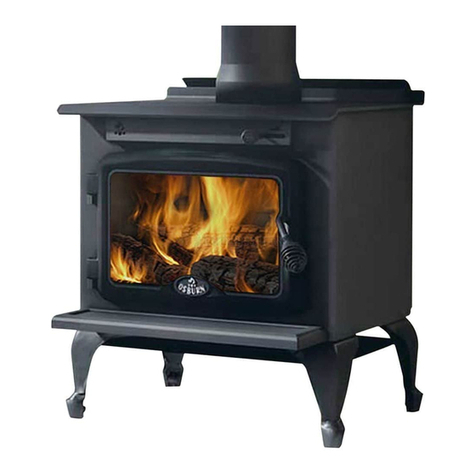
Osburn
Osburn OB00900 User manual
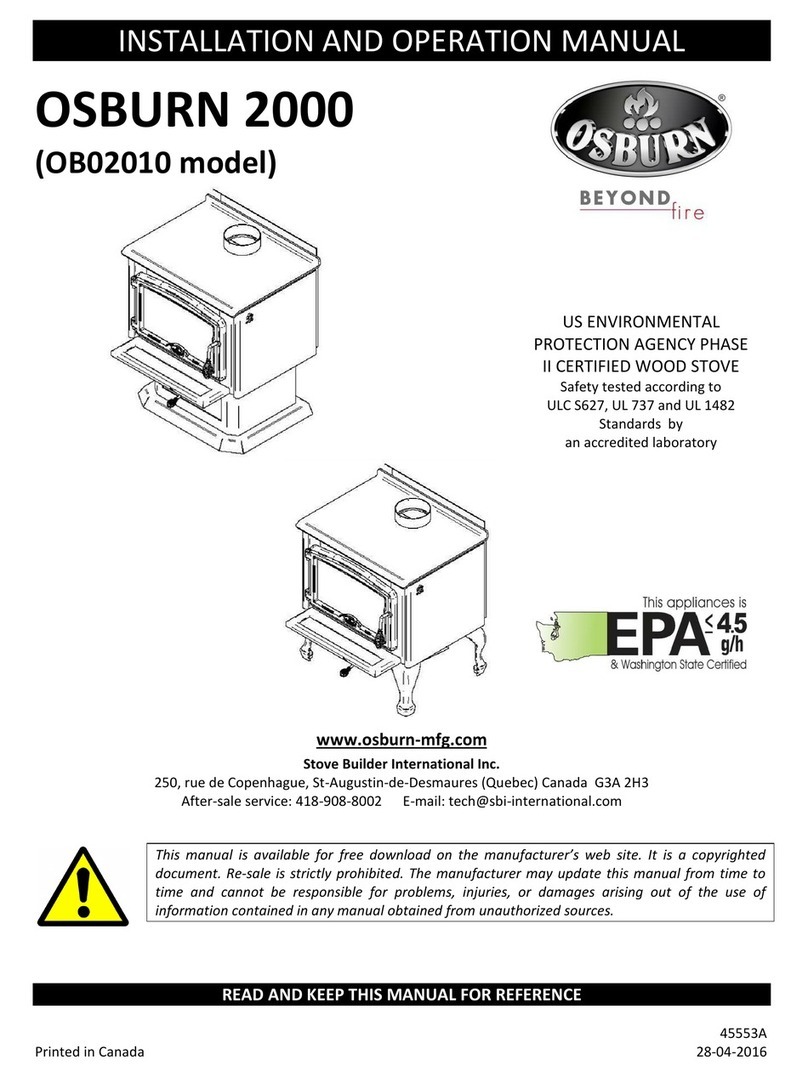
Osburn
Osburn 2000 User manual

Osburn
Osburn 2300 User manual
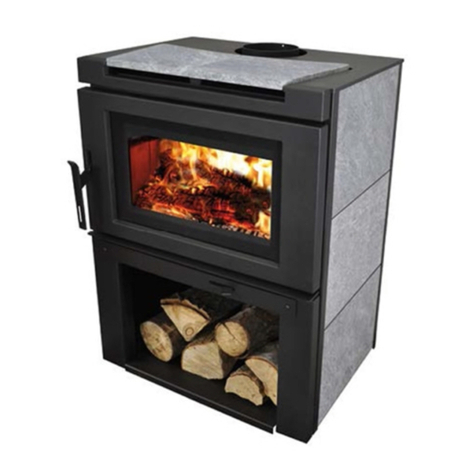
Osburn
Osburn MATRIX OB02022 User manual
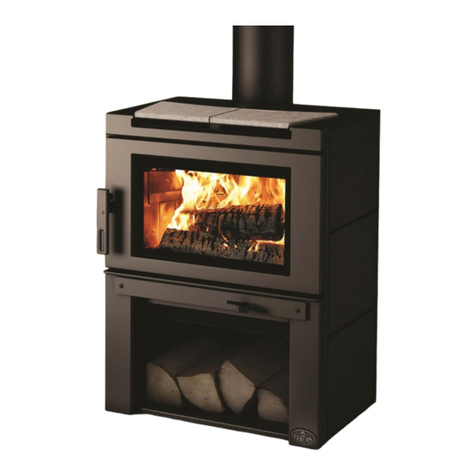
Osburn
Osburn MATRIX User manual

Osburn
Osburn 2000 User manual
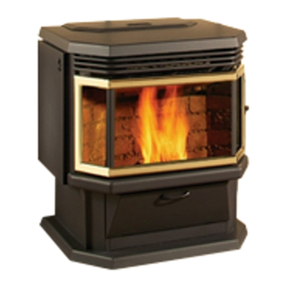
Osburn
Osburn HYBRID-45 MF User manual
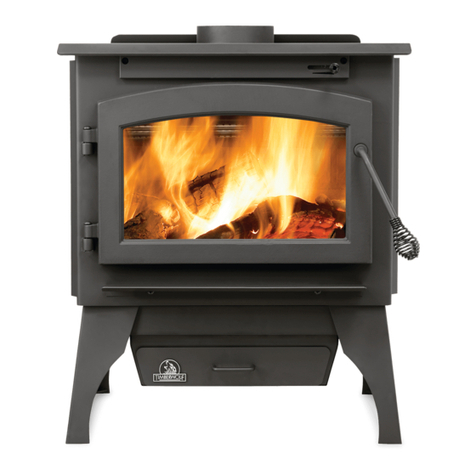
Osburn
Osburn 3300 User manual
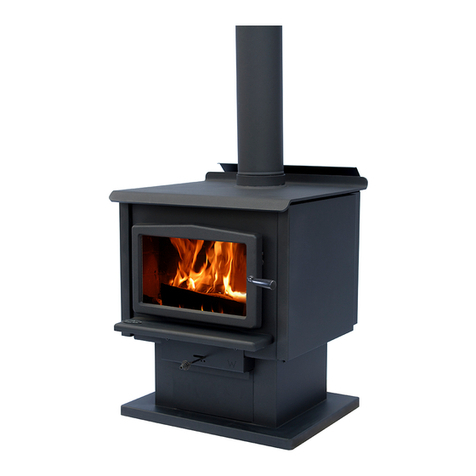
Osburn
Osburn 1600 User manual

Osburn
Osburn MATRIX OB02020 User manual
Popular Wood Stove manuals by other brands

RAIS
RAIS attika NEXO 100 GAS installation guide

WoodPro
WoodPro WS-TS-1500 owner's manual

Contura
Contura C 586W installation instructions

Palazzetti
Palazzetti EVA GENERAL INFORMATION - WARNINGS - INSTALLATION - MAINTENANCE

Lopi
Lopi 1250 Republic owner's manual

Panadero
Panadero CAPRI 3V Usage and maintenance instructions
